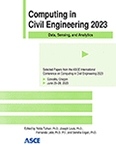Exploration of Indoor Navigation Technologies and Development of a Prototype Application
Publication: Computing in Civil Engineering 2023
ABSTRACT
As university buildings become more complex, navigating them and finding rooms and exits, especially for newcomers, has become increasingly difficult. This study aimed to explore the literature on indoor navigation technologies, examine the use of as-built 3D scans in indoor navigation, and develop a prototype application to assist users in locating facilities such as restrooms or exits during emergencies in a university building. The study analyzed data, evaluated the perceptions of students who visited the building, and developed a prototype application based on a 3D scan of a university building. The study used a Faro laser scanner to scan the indoor hallway of the building and collected 3D point cloud data, which was converted into a mesh model and an area target using the Vuforia engine. The study then exported the mesh model and area target to a Unity application to develop the prototype indoor navigation application using the Vuforia engine and Unity.
Get full access to this article
View all available purchase options and get full access to this chapter.
REFERENCES
Atzori, L., Dessi, T., and Popescu, V. (2012). Indoor navigation system using image and sensor data processing on a smartphone. 2012 13th International Conference on Optimization of Electrical and Electronic Equipment (OPTIM), 1158–1163. https://doi.org/10.1109/OPTIM.2012.6231975.
Birla, S., Singh, G., Kumhar, P., Gunjalkar, K., Sarode, S., Choubey, S., and Pawar, M. (2020). Disha-Indoor Navigation App. 2020 2nd International Conference on Advances in Computing, Communication Control and Networking (ICACCCN), 517–522. https://doi.org/10.1109/ICACCCN51052.2020.9362984.
Borenstein, J., Everett, H. R., and Feng, L. (1996). Navigating mobile robots : systems and techniques. A K Peters.
Dhobale, M. D., Verma, P. S., Joshi, P. R., Tekade, J. K., and Raut, S. (2019). A review on indoor navigation systems and technologies for guiding the users. International Journal of Scientific Research in Computer Science, Engineering and Information Technology.
Glanzer, G., and Walder, U. (2010). Self-contained indoor pedestrian navigation by means of human motion analysis and magnetic field mapping. 2010 7th Workshop on Positioning, Navigation and Communication, 303–307. https://doi.org/10.1109/WPNC.2010.5650917.
Golledge, R. G. (1995). Path selection and route preference in human navigation: A progress report. 207–222. Berlin, Heidelberg: Springer Berlin Heidelberg.
Huang, B.-C., Hsu, J., Chu, E. T.-H., and Wu, H.-M. (2020). ARBIN: Augmented Reality Based Indoor Navigation System. Sensors, 20(20), Article 20. https://doi.org/10.3390/s20205890.
Koch, C., Neges, M., König, M., and Abramovici, M. (2014). Natural markers for augmented reality-based indoor navigation and facility maintenance. Automation in Construction, 48, 18–30. https://doi.org/10.1016/j.autcon.2014.08.009.
Lehtola, V. V., Nikoohemat, S., and Nüchter, A. (2021). Indoor 3D: Overview on Scanning and Reconstruction Methods. In: Werner, M., Chiang, YY. (eds) Handbook of Big Geospatial Data. Springer, Cham. https://doi.org/10.1007/978-3-030-55462-0_3.
Montello, D. (2005). Navigation. In P. Shah & A. Miyake (Eds.), The Cambridge Handbook of Visuospatial Thinking (Cambridge Handbooks in Psychology, pp. 257–294). Cambridge: Cambridge University Press. doi:https://doi.org/10.1017/CBO9780511610448.008.
Mulloni, A., Seichter, H., and Schmalstieg, D. (2011). Handheld augmented reality indoor navigation with activity-based instructions. Proceedings of the 13th International Conference on Human Computer Interaction with Mobile Devices and Services, 211–220. https://doi.org/10.1145/2037373.2037406.
Rubio-Sandoval, J. I., Martinez-Rodriguez, J. L., Lopez-Arevalo, I., Rios-Alvarado, A. B., Rodriguez-Rodriguez, A. J., and Vargas-Requena, D. T. (2021). An Indoor Navigation Methodology for Mobile Devices by Integrating Augmented Reality and Semantic Web. Sensors, 21(16), Article 16. https://doi.org/10.3390/s21165435.
Simões, W. C. S. S., Machado, G. S., Sales, A. M. A., de Lucena, M. M., Jazdi, N., and de Lucena, V. F., Jr. (2020). “A Review of Technologies and Techniques for Indoor Navigation Systems for the Visually Impaired” Sensors 20, no. 14: 3935. https://doi.org/10.3390/s20143935.
Tóth, Z. (2016). ILONA: Indoor localization and navigation system. Journal of Location Based Services, 10(4), 285–302. https://doi.org/10.1080/17489725.2017.1283453.
Verma, P., Agrawal, K., and Sarasvathi, V. (2020). Indoor Navigation Using Augmented Reality. Proceedings of the 2020 4th International Conference on Virtual and Augmented Reality Simulations, 58–63. https://doi.org/10.1145/3385378.3385387.
Wakchaure, M., Tamboli, M., and Sonkar, S. (2022). Indoor Navigation System for Public Evacuation in Emergency Situation. Journal of Physics: Conference Series, 2327(1), 012062. https://doi.org/10.1088/1742-6596/2327/1/012062.
Weisman, J. (1981). Evaluating architectural legibility: Way-finding in the built environment. Environment and behavior, 13, 189–204.
Yoon, S., Jung, J., and Heo, J. (2015). Practical Implementation of Semi-Automated As-Built BIM Creation for Complex Indoor Environments. ISPRS - Int. Arch. Photogramm. Remote Sens. Spat. Inf. Sci. XL-4/W5, 143–146.
Yuan, Y., Kong, X., Fang, G., Liu, L., and Khruahong, S. (2019). Development of Semantic Model of Multi-Level-Building Navigation Using Indoor Ontology and Dijkstra’s Algorithm. 2019 20th International Conference on Parallel and Distributed Computing, Applications and Technologies (PDCAT), 505–508. https://doi.org/10.1109/PDCAT46702.2019.00100.
Information & Authors
Information
Published In
History
Published online: Jan 25, 2024
ASCE Technical Topics:
- Automation and robotics
- Bibliographies
- Buildings
- Colleges and universities
- Computer vision and image processing
- Education
- Engineering fundamentals
- Engines
- Equipment and machinery
- Geomatics
- Information management
- Methodology (by type)
- Models (by type)
- Navigation (geomatic)
- Practice and Profession
- Structural engineering
- Structures (by type)
- Systems engineering
- Three-dimensional models
Authors
Metrics & Citations
Metrics
Citations
Download citation
If you have the appropriate software installed, you can download article citation data to the citation manager of your choice. Simply select your manager software from the list below and click Download.
